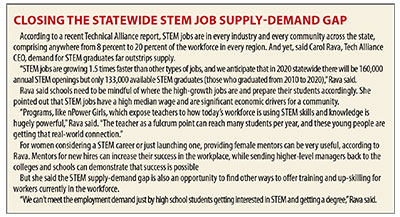While studies show girls’ and boys’ academic abilities in STEM (Science, Technology, Engineering and Math) are at parity in high school, only about 25 percent of STEM jobs are held by women.
The paucity of women pursuing STEM careers inspired Vickei Hrdina to found the nPower Girls program in 2014. Hrdina is currently the STEM director at Educational Service District 112 (ESD 112) as well as the co-director at SW Washington STEM Network and director of the Southwest LASER (Leadership and Assistance for Science Education Reform) Alliance.
“We want to inspire girls to think about themselves in STEM-related careers by enriching the in-classroom environment,” Hrdina said. “We want teachers to be well informed about the STEM jobs and resources locally available and shift their instructional practice to be more inclusive toward girls’ skills.”
Hrdina explained that while there are a fair number of STEM programs focused on girls, such as robotics clubs, they are almost all either afterschool or camp based. This can marginalize certain populations who may not be able to afford a summer STEM camp or provide transportation to afterschool activities.
Hrdina has first-hand experience with teaching STEM classes. Twelve years ago, she was the only woman teaching STEM courses in the entire state of Indiana. When she moved to Vancouver a few years ago, she said she expected to see more women in STEM job roles, since the STEM ecosystem is larger here than in the Midwest. But she was dismayed to find that, except for the life sciences, women are still severely under-represented in the STEM community.
Carol Rava, CEO of the Technical Alliance, a statewide, nonprofit organization of leaders from Washington’s technology-based businesses and research institutions, said that culture has a lot to do with why women fail to pursue STEM careers.
“Everyone wants to work in an environment where they feel welcome and can see a path for success – ‘see it be it’,” Rava said. “A lack of diversity fuels a lack of diversity.”
In addition, Rava continued, the pipeline is further limited for both boys and girls by scanty availability of STEM classes. For example, in 2016 AP computer science was offered in only 10 percent of Washington’s high schools.
So, why should learning institutions and the business community care about gender diversity and promoting women in STEM roles? First, Hrdina said, having a female perspective when designing products can lead to better designs. Think about a bicycle, for example. Male designers may not consider hand size when designing handlebars; having females on the team can help broaden product appeal. Women can also deepen the scope and style of communication skills across the enterprise and with customers. Rava added that studies show that companies with a diverse workforce (with respect to both gender and ethnicity) have a stronger culture and are higher performing, and that the success rate for startups that have a woman as a cofounder is significantly higher than those who are led only by men.
The nPower Girls program, currently funded by a federal math and science partnership grant, seeks to help teachers help young girls better understand their STEM skills and realize that these skills can help them be successful in any workplace. Now in its fourth year, nPower partners with the business community by organizing “mini-externships,” where teachers visit a business, take a tour, and meet different female employees and learn about what they do.
“The teachers learn about jobs and are introduced to potential mentors,” Hrdina said. “Teachers also are introduced to real-world problems the businesses are trying to solve. They can translate this knowledge into classroom instruction.”
Recently, Vancouver’s Nautilus, Inc. hosted such an event, where 30 ESD 112 teachers met with nearly a dozen female Nautilus employees, from firmware and mechanical engineers to business systems analysts and user interface designers.

“We consider ourselves an innovation company – we make in-home fitness equipment, but we’re more about innovation, design and new ways of thinking about home fitness,” said Erin Beck, corporate communications manager at Nautilus. “By opening our doors to nPower Girls and educators, we can showcase what we’re doing and prove that STEM can be found just about everywhere.”
nPower Girls started out working with seven school districts and 14 teachers in rural, isolated and at-risk communities. Schools ranged from Wishram to Vancouver to Castle Rock. Hrdina said that through some increased funding from other nonprofits the program has grown to 11 districts, one private school and 23 teachers.
The number of businesses that work with nPower Girls has grown to 24, and teachers now have access to 10 separate units of instructional materials that are based on real-world-problems.
“Kids are working on actual authentic problems driven by regional businesses,” Hrdina said. “And these are available globally on our website, not just to Southwest Washington teachers.”
Beck is enthusiastic about nPower Girls’ success.
“I love the angle of supporting STEM and females,” she said. “Diversity in the workplace is very important to us, and we want to inspire the next generation of designers, innovators and creators.”
Hrdina said that the idea of connecting teachers to local businesses has been even more powerful than she anticipated, and she encourages businesses to contact her at vickei.hrdina@esd112.org. Besides hosting one of the externships, businesses may also consider sponsoring a portion of the program, as funding runs out next summer.
“We want to have a close partnership with businesses in Southwest Washington,” Hrdina said. “I hope more will get involved. It will all end up benefitting the kids.”